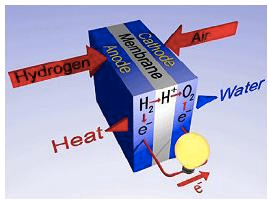Green hydrogen
Hydrogen is derived primarily by splitting water or by reacting fossil fuels with steam or controlled amounts of oxygen. Most hydrogen is produced today using fossil fuels, but the great promise of hydrogen is its potential to be produced with zero greenhouse gas emissions. Green hydrogen is produced by extracting hydrogen from water by passing an electrical current through the water in a process called electrolysis. To be classified as green hydrogen, the process must use electricity generated from a renewable source such as solar or wind. Hydrogen can be fed into a fuel cell to make electricity or burnt to produce heat.
Applications for hydrogen include: power generation, transport, industrial feedstocks and heating. The applications most relevant to agriculture are power generation, particularly in off-grid and fringe-of-grid locations, and heavy vehicle transport. Fuel cell electric vehicles have a more favourable energy density by mass than battery electric vehicles, allowing greater distances to be travelled without refuelling/recharging. Current barriers to uptake of fuel cell electric vehicles include their relatively higher cost and lack of infrastructure.
Green hydrogen technologies are currently more expensive than fossil fuel alternatives, but costs are projected to reduce significantly in the coming decades with technology advances, increased scale of production, and the continued decline in the costs of renewable power generation.
For more information about green hydrogen, see the Diesel use in NSW agriculture and opportunities to support net zero emissions report (PDF, 1741.56 KB)
Green energy videos
Dr Neil Thompson has been a guest presenter for NSW DPI at forums, webinars and field days with DPI's H2Cuts mobile hairdresser trailer. Neil created the following series of 3 videos to give some insight into the various ways hydrogen can be part of the future energy solution.